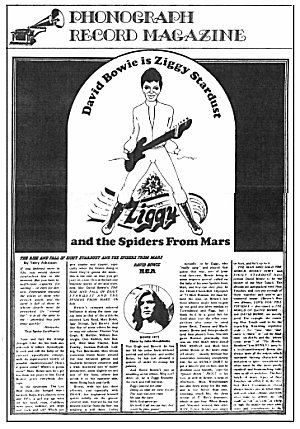 Companion
Companion![]() The
The  Companion
Companion
Home ¦ Index ¦ FAQ ¦ Encyclopaedia ¦ Timeline ¦ Songs ¦ Gallery ¦ E-mail
| Reviews | ||

by Jim Bickhart - Phonograph Record Magazine (July 1972)
Since jumping from Mercury to RCA, David Bowie has added the decipherable touch to his recordings which they needed to reach more than the esoteric crew of rock critics that his two Mercury albums were embraced by. Consequently the newer records HUNKY DORY and now ZIGGY STARDUST are selling and Bowie is ripping up English audiences with a stage show designed to embarrass everyone from T. Rex to the Cockettes.
Five years ago, Bowie was making typically English rock and roll story records, his image late-sixties flash mod flower phase child. He then moved on to poetry and art rock, going through a semi-acoustic and an odd hit record called "Space Oddity", which reflected both his interests in rebelliousness and intergalactic matters. Next came some very electric, at times almost heavy-metal psychotic commentary by way of a powerful album called THE MAN WHO SOLD THE WORLD.
ZIGGY STARDUST, the out growth of Bowie’s new openness is a self-contained rock and roll album about rock and roll. Bowie’s band, guitarist Mick Ronson, bassist Trevor Bolder and drummer Mick Woodmansey, team with the singer-guitarist to both perform and play the roles depicted in the album’s songs: to a limited extent, they are Ziggy Stardust and the Spiders from Mars. And most certainly they are an excellent rock band.
The songs, beginning with the doom-portending "Five Years", creates a tale in which a number of Bowie’s beliefs and fantasies are placed in full view. The thread of the plot goes from the announcement of impending doom through the uncontrollability of love ("Soul Love") to a major turning point, "Moonage Daydream", where Ziggy, whoever he is before he actually becomes Ziggy, is zapped by a combination of religion (first invoked at the end of "Soul Love" ), romance, rock and roll and bisexuality. Symbolically it is probably the album’s most important number.
From this point, the new rock and roll idol, obstensively an invader from space (though it is really space in someone’s imagination), begins making himself public. "Starman" presents his arrival on earth both as a physical phenomenon and as a religious occurrence. A stylised rendition of Ron Davies funky "It Ain’t Easy" takes Ziggy on a sexual tangent to finish Side One.
Side Two is more directly devoted to the rise and fall of Ziggy and the Spiders. "Lady Stardust" says, in no uncertain terms, that this rock star appeals sexually to everyone in the audience, just as it is actually the case with most superstars (Bowie, though, has a way of not mincing his words). "Star" offers the singer’s motivation for seeking fame, and "Hang Onto Yourself" describes the position of the band as they begin to discover the nature of their appeal and precisely what they must do to make it big. "Ziggy Stardust" compresses, in rock ballad form, the basic story of the band’s fling with stardom. The final pair of numbers, the ballsy "Suffragette City" and "Rock and Roll Suicide" are a bit anti-climatic in content. "Suffragette City" is pure lust and out of sequence (it would seem more comfortable if heard before the idea of Ziggy’s downfall is introduced), though it is the album’s classic rocker in the Rolling Stones sense. "Suicide" is a symbolic reference for the idea of what the forgotten idol does after the fall.
David Bowie, on the strength of his five albums, is certainly on of the more distinctive personalities in rock, and that alone is enough to make his very listenable records a bit extra-ordinary. Even if some of his ideas don't quite work out, his talent for strong conception and sound execution is undeniable. Should he become a star of Ziggy Stardust magnitude, he will deserve it, and hopefully his daydreams won’t be forced to turn to suicide when it’s all over.
---This page last modified: 13 Dec 2018---